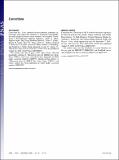Core epithelial-to-mesenchymal transition interactome gene-expression signature is associated with claudin-low and metaplastic breast cancer subtypes
Author(s)
Taube, Joseph H.; Herschkowitz, Jason I.; Komurov, Kakajan; Zhou, Alicia Y.; Gupta, Supriya; Yang, Jing; Hartwell, Kimberly A.; Gupta, Piyush; Evans, Kurt W.; Hollier, Brett G.; Ram, Prahlad T.; Rosen, Jeffrey M.; Mani, Sendurai A.; Onder, Tamer T; Lander, Eric Steven; Weinberg, Robert A; ... Show more Show less
DownloadGupta_Core epithelial.pdf (1.554Mb)
PUBLISHER_POLICY
Publisher Policy
Article is made available in accordance with the publisher's policy and may be subject to US copyright law. Please refer to the publisher's site for terms of use.
Terms of use
Metadata
Show full item recordAbstract
The epithelial-to-mesenchymal transition (EMT) produces cancer cells that are invasive, migratory, and exhibit stem cell characteristics, hallmarks of cells that have the potential to generate metastases. Inducers of the EMT include several transcription factors (TFs), such as Goosecoid, Snail, and Twist, as well as the secreted TGF-β1. Each of these factors is capable, on its own, of inducing an EMT in the human mammary epithelial (HMLE) cell line. However, the interactions between these regulators are poorly understood. Overexpression of each of the above EMT inducers up-regulates a subset of other EMT-inducing TFs, with Twist, Zeb1, Zeb2, TGF-β1, and FOXC2 being commonly induced. Up-regulation of Slug and FOXC2 by either Snail or Twist does not depend on TGF-β1 signaling. Gene expression signatures (GESs) derived by overexpressing EMT-inducing TFs reveal that the Twist GES and Snail GES are the most similar, although the Goosecoid GES is the least similar to the others. An EMT core signature was derived from the changes in gene expression shared by up-regulation of Gsc, Snail, Twist, and TGF-β1 and by down-regulation of E-cadherin, loss of which can also trigger an EMT in certain cell types. The EMT core signature associates closely with the claudin-low and metaplastic breast cancer subtypes and correlates negatively with pathological complete response. Additionally, the expression level of FOXC1, another EMT inducer, correlates strongly with poor survival of breast cancer patients.
Date issued
2010-08Department
Massachusetts Institute of Technology. Department of Biology; Whitehead Institute for Biomedical ResearchJournal
Proceedings of the National Academy of Sciences
Publisher
National Academy of Sciences (U.S.)
Citation
Taube, J. H., J. I. Herschkowitz, K. Komurov, A. Y. Zhou, S. Gupta, J. Yang, K. Hartwell, et al. “Core epithelial-to-mesenchymal transition interactome gene-expression signature is associated with claudin-low and metaplastic breast cancer subtypes.” Proceedings of the National Academy of Sciences 107, no. 35 (August 31, 2010): 15449-15454.
Version: Final published version
ISSN
0027-8424
1091-6490